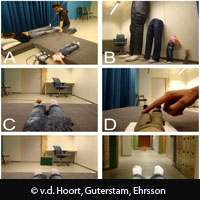Why our brains sense Barbie doll-size experience
What would you think if you woke up one morning and imagined that your body had shrunk down to a doll's size? You might think that you were your normal size but everyone else was huge, or that you were tiny. So the question is: how does our body size affect how we see our world? Researchers in Sweden tackled this question and got results. Published in the journal PLoS ONE, the study was funded in part by a European Research Council (ERC) grant under the EU's Seventh Framework Programme (FP7). Classical theory suggests that we perceive size and distance as being a product of how the brain interprets different visual cues like the size of an object on the retina and how this object moves across the field of vision. Some experts believe this is also the case for body size and its relation to perception. They claim that the taller you are, the shorter distances appear to be. Putting these assumptions to the test, the researchers from Karolinska Institutet examined how people would experience a tiny body or a huge body as their own in a laboratory setting. After having successfully created the illusion of body-swapping with other people or mannequins, the Karolinska team used the same techniques to create the illusion of a person having either a large body or doll-sized body. Subjects experienced the ownership of a doll's body (80 centimetres or 30cm) and a giant's body (400cm). Their work reveals how our body size influences our perception of the space around us. 'Tiny bodies perceive the world as huge, and vice versa,' explains senior author and leader of the study Dr Henrik Ehrsson from the Brain, Body and Self Laboratory, Department of Neuroscience, Karolinska Institutet. The team evaluated the altered perception of space by asking study participants to estimate the size of various blocks and then walk over to the blocks with their eyes shut. When the subjects imagined having a small body, they overestimated size and distance. The opposite occurred when large bodies were imagined. The researchers point out that one of the strategies the brain uses to assess size is to compare two objects; for example a body and a tree (standing side by side). But when the subjects experienced a sense of ownership of the artificial bodies, the 'body size effect' was greater, they say. 'Even though we know just how large people are, the illusion makes us perceive other people as giants; it's a very weird experience,' Dr Ehrsson says. The research also reveals how the chances of creating an illusion of body-swapping with significantly small or large artificial bodies are high. This effect could have practical applications in the long run. 'It's possible, in theory, to produce an illusion of being a microscopic robot that can carry out operations in the human body, or a giant robot repairing a nuclear power plant after an accident,' Dr Ehrsson explains. The researchers say the findings are 'fundamentally important as they suggest a causal relationship between the representations of body space and external space. Thus, our own body affects how we perceive the world'.For more information, please visit:Karolinska Institutet: http://ki.se/?l=enPLoS(opens in new window) ONE:http://www.plosone.org/home.action
Countries
Sweden



